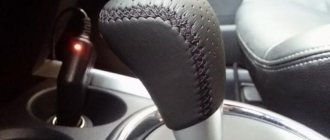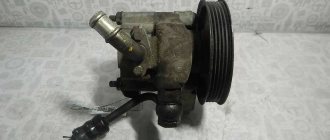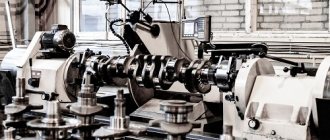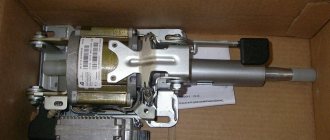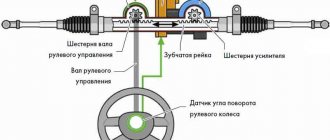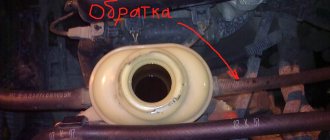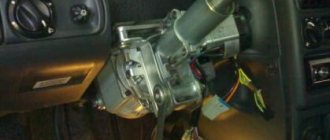Selecting material for steering wheel reupholstery
Success depends to a large extent on the correct selection of material. The best option is genuine leather, which is distinguished by its durability, aesthetic appearance and a fairly large variety.
- When choosing, take into account the thickness of the material. Skin that is too thin is not interesting from a practical point of view.
- It is easier to work with, but this steering wheel braid will not last very long.
- Thick skin is difficult to pierce with a needle, so the work will take a lot of time and effort.
- The best solution is a material of natural origin with a thickness of about 1.3 mm.
It is necessary to find a sufficiently elastic material; medium elongation guarantees an excellent fit of the cover to the steering wheel.
The presence or absence of perforation is not a prerequisite. But smooth leather without unnecessary marks will last longer.
Additional materials and tools
It is recommended to stock up in advance everything you need to reupholster the steering wheel with leather. This will allow you not to be distracted while working.
In addition to genuine leather you will need:
- Needle;
- Durable nylon thread;
- Cling film;
- Masking tape;
- Marker (felt-tip pen);
- Sharp construction knife.
Given the specific features of the material, a thimble to protect your fingers will be useful.
Choosing skin
Choosing a material for tuning is a fascinating process. Color scheme, combination of leather of different textures, price and availability of materials in stores... Black color is universal, it is an eternal classic of the genre, but it is unlikely to be appropriate in a beige interior. Choose soft leather, consider perforated options. This material is easily fixed by hand and has a high coefficient of friction.
Where to buy covering material? Go to an auto shop, visit fabric stores, or look at online store catalogs. The pattern of the product will tell you the required amount of leather.
Please note: ALCANTARA leather Alcantara (faux suede). Thanks to the adhesive base and protective adhesive paper, it is easy to work with. The pattern is drawn on adhesive paper, cut out with scissors, the protective layer is removed, the leather is stretched exactly to the shape of the steering wheel and glued in the right places.
Preparatory stage
The first step is to remove the steering wheel. You will need to first remove the terminals from the battery. If the car is equipped with an airbag, then you need to wait about five minutes and then remove the steering wheel. When dismantling the steering wheel, it is recommended to follow the operating and repair instructions for the vehicle of the corresponding brand.
It is necessary to remove the old braid from the steering wheel, if any. To do this, you can simply cut it with a sharp knife along the seams, being careful not to scratch the base.
- The steering wheel is thoroughly cleaned of dirt. Then they wrap it in cling film and stick masking tape on it. All manipulations are performed very carefully, the winding should be tight, without bubbles or distortions.
- Markings are applied to a layer of masking tape with a marker or felt-tip pen. The future pattern is divided into four parts, and the markings are applied to the inside of the steering wheel. This is where the connecting seam will be. The received parts are numbered.
- The tape is cut along the marking lines and then removed from the base. After this they need to be leveled. This will help to avoid inaccuracies when cutting the material. To do this, the resulting parts are placed on a flat surface and pressed down with a weight for several hours.
An alternative solution is to accurately transfer the outlines of the resulting templates onto a sheet of cardboard. In this case, the existing parts of the future pattern should be carefully straightened and fixed on the cardboard.
Making patterns is an important stage of work; the final result of the entire work directly depends on accuracy.
Dimensions
To find out the size of the steering wheel cover, you need to measure its diameter. If you need to make a gift, there is a standard table for all types and sizes of steering wheel braids.
- S (35-37 cm) – small cars (Oka, Tavria, Kia Picanto)
- M (37-39 cm) - universal size for most passenger cars and medium crossovers from Europe and Japan
- L (39-40 cm) – early VAZ, Volga and Moskvich models and American models
- XL (42-43 cm) – UAZ, Gazelle, Sobol models
- XXL (47 cm) – foreign trucks
- XXXL (49 cm) – KAMAZ.
Manufacturers of high-quality braids include “Autoprofi”, “Autoluxe”, “Sparco” and “Aligator”. These are popular and well-known companies, known to every car enthusiast for the large number of car accessories they produce.
There are many nameless Chinese factories that make leather and leatherette products, and not always of poor quality. But it depends. There are plenty of other small manufacturers
There is always a choice, it is important to know what your darling wants!
Uncover
After completing the work on creating the patterns, you can begin cutting. The prepared material is placed on a flat surface, the markings are applied to the wrong side.
When cutting, allowances for connecting seams should be left within 1.5-2 mm. Each part should be labeled to avoid confusion.
When working with genuine leather, it is recommended to cut it on a flat surface with a sharp knife or blade. This will allow you to get an even and neat cut.
Kinds
When choosing a steering wheel braid, you will be faced with a wide selection of materials. The most popular types include the following:
- woven leather and faux leather;
- fluffy braids;
- braided wire;
- silicone caps;
- foam covers.
Useful bracelets can be put into a separate category: in addition to their main functions, they offer a number of additional benefits. These include, for example, heated steering wheel pads and massage cushions. Let's look at each type in more detail.
Leather braids
As we have already said, both natural and artificial leather are used to make braids. Of course, genuine leather will be more durable, soft and pleasant to the touch than artificial leather. However, its price can be 3-4 times higher, making it unaffordable for many drivers. Both artificial leather (also known as eco-leather) and genuine leather have good performance properties. This material does not fade in the sun and does not swell from moisture. Not afraid of temperature changes.
When choosing such a braid, preference should be given to perforated leather. It is softer to the touch and allows air to pass through better, creating a breathable effect.
perforated leather is much softer than regular leather
Fur
Fur used in performance fabrics can also be faux or natural. Natural fur retains heat better in cold weather. Although, if you do not ride in Arctic cities, artificial material will work just as well. Sheepskin is often used to make covers.
Sheepskin is very popular for making steering wheel braids.
Faux fur with long hair is often dyed in bright colors and added with fun elements. Using such a coating will make the car owner cheerful and carefree. Such cases are most often chosen by young women.
A fur braid with long multi-colored hair will look charming in the interior of a woman's car.
Wicker covers
Wire braids are also called retro braids because they were very popular in the middle of the last century. Today they are used by those who want to turn their iron horse into a classic Soviet-era car.
Braided covers retain their main functions: they protect the steering wheel from damage and prevent your hands from slipping. Moreover, their price is significantly lower than that of leather and fur counterparts. The most popular material for making pigtails is regular insulated wire, which can be found in almost any garage. Some craftsmen make braids from thin and stiff ropes.
Use the woven wire cover to decorate your car with retro style
The braid can be ordered from a specialized workshop or made independently using weaving patterns. Braids can be ordered from specialized workshops or made independently using weaving patterns.
Silicone and foam covers
Silicone or foam rubber are often used to make steering wheel covers. The production technology makes it possible to produce cases from these materials inexpensively, but copes well with all tasks. The colors of these braids are very diverse: you can find both calm pastel shades and bright neon colors. Foam covers often come in multi-colored designs, and clear silicone protects the handlebars while still maintaining its original appearance.
Sleeves with silicone braiding can be either bright or more muted shades
Useful braids
As mentioned earlier, heated seat covers can be considered beneficial. They can be made from any material, but the most common are genuine leather or eco-leather. Simply connect the wire from the cover to the cigarette lighter, and additional hand heating is provided.
additional heating inside the steering wheel braid for greater comfort in winter
Braided massage mats are usually made of rubber. The special relief affects specific points on the hands to improve blood circulation, thereby preventing fatigue and stiffness of the hands.
Massage pads on the steering wheel have a positive effect on blood circulation in the hands
Stages of work
All work on reupholstering the steering wheel with leather can be divided into several stages:
- Removing the steering wheel;
- Removing the pattern;
- Cutting the material;
- Preparing the base (steering wheel);
- Making connecting seams;
- Steering wheel cover.
The elements obtained during cutting should be sewn together in such a way as to form a circle. Connecting seams are performed manually or using a sewing machine. This depends on the availability of equipment and sewing skills, as well as on the thickness of the material.
The seams must be made at a distance of at least 2 mm from the edge. Otherwise, there is a high risk of damage to the material during tension.
It is recommended to try on the blank obtained at this stage on the steering wheel. The resulting circle should fit tightly on the steering wheel. If it moves freely around the steering wheel, then it is recommended to close the transverse seams a little.
The steering wheel also requires attention. It must be inspected; any minor damage is recommended to be covered with tape.
After preparing the base, you can proceed to covering the steering wheel with leather. To do this, stretch the existing blank onto the steering wheel and begin stitching the edges.
This is quite a painstaking job that can take several hours. The duration of this stage largely depends on the type of stitch chosen to join the edges.
Blank
Next, you need to take the material that was chosen for the cladding and apply markings to the back side of it. It is for this purpose that we need a marker and a ready-made template. It is advisable to choose a square-shaped piece of material. Thanks to this solution, you can save your skin.
The workpiece consists of a couple of parts. One part will be used for the steering wheel rim trim, and the second for the central component.
Once again we make sure that the markings are applied correctly and cut out the necessary blanks along the lines made.
See also: How to purify water yourself at home: freezing
How to secure a seam
The service life of a new leather steering wheel depends on the strength of the connecting seam. In practice, different fastening options are used, thanks to which the connecting seam is held.
It can be:
- Stitches along the edges of the parts;
- Holes.
Stitching along the edge of a piece is very simple. To do this, use a household sewing machine. You will need to stitch along the cut of the part at a distance of about 4 mm from the edge. It will be easier to pass a needle and thread into the holes formed as a result of this operation, and the seam will ultimately be smooth with stitches of the same size.
If this is not possible, then you need to make the holes manually using an awl or a sewing machine needle. This is a very labor-intensive method, because you need to make at least 600 holes at equal distances.
Why leather?
- The leather steering wheel evokes a pleasant tactile sensation and is warm to the touch.
- The leather steering wheel is securely fixed in the hand, making it easier for the driver to react to unexpected road situations.
- A leather steering wheel looks restrained and elegant or young and playful, depending on the color and quality of the material.
Wondering which radar detector to choose? You will find the answer in this article.
Are you just starting to master the car? Find out how to change a tire on your car.
How to make a seam
There are many options for connecting parts.
Zigzag seam
The simplest solution is lacing, which is similar in design to shoe lacing. Starting from the bottom part, I insert a needle with a strong thread into the holes prepared in advance.
- You must move counterclockwise. It is required to continuously monitor the sheathing process, carefully aligning the edges of the parts. The thread should be stretched tightly, without sagging.
- If the skin does not straighten out well, then it must be heated using a regular hair dryer. This will make it more elastic and pliable, which will eliminate the defect.
- After finishing connecting the parts, the knots must be removed inside. It is recommended to additionally glue the seam with special glue. Using a hair dryer to warm up will allow the skin to adhere thoroughly to the surface of the car steering wheel.
If desired, you can use herringbone lacing, or imitate cross stitch. Often, when reupholstering the steering wheel, the so-called “baseball stitch” is used.
Externally, the seam resembles a tie on a baseball. A similar seam is often found on other interior elements of the car. The work uses two threads, weaving them into a braid.
Hexagonal seam
This pattern is used when there are stitched seams along the edges of the parts to be joined.
- The needle and thread are passed under the parallel stitches on the parts to be joined.
- The next step is performed in one stitch (or two if the stitching on the edges is done in very small steps).
- The result is spectacular hexagons with a stripe running diagonally.
Pentagonal seam
The joining method is used when there is a sewing line on the edges of the joined elements. In this case, the stitches should be short enough.
- The needle and thread are passed alternately, each time skipping one opposite stitch.
- The thread passes into the next stitch from the reverse side.
- At the junction of the elements, interesting pentagonal-shaped segments are formed.
- This connection is known as a Euroseam, as it is practiced by many European companies.
Diamond stitch
Segments of the connecting seam in the form of diamonds, crossed by a transverse line, are formed when there are stitched seams along the edges of the parts.
It is necessary to pass every two opposite stitches, passing the needle and thread from the same side. In other words, the needle always moves in the same direction.
The choice of connection option depends on the skills and personal preferences of the home craftsman. An excellent result will be obtained in any case, provided that the work is done carefully.
How to easily determine brake disc wear by visual inspection
- Take a strong thread, insert it into an equally strong needle;
- You need to retreat about 2-3 mm from the edge of the skin. If you sew too close to the edge, it will simply tear under tension;
- All the blanks need to be connected, resulting in a ring. This is why it is important to mark your patterns with a marker;
- The inner seam will be on the inside, so don’t worry about this;
- When the ring is ready, place it on the steering wheel, align all the edges so that everything matches;
- The leather will “walk” around the wheel if it is not secured. Here I solved the problem this way - I treated the steering wheel with epoxy resin. It held the skin firmly, but at the same time allowed the material to be slightly shifted until drying;
- Sew all edges neatly. If you are good with thread and needle, you can get a beautiful decorative seam;
- Stretch the skin evenly so that the tension is approximately the same everywhere.
The formation of small folds on a new case should not scare you. This is normal for the skin. In a few days everything will smooth out and look perfect. Be patient.
I told you what the process of covering the steering wheel looks like. Yes, the task is not the easiest, but it is doable. If you are not ready for it, take the steering wheel to a workshop. There they will do everything for you in the best possible way, although for a decent amount of money.
Share your stories about re-upholstering your steering wheel yourself or your bad experience with a repair shop, if you have one. To do this, write in the comments.
Don't forget to subscribe and tell your friends about the existence of our site! We will be very grateful to you for this!
Rules of care
Proper care of the braid will extend its service life.
It is recommended to periodically clean stains with mild detergents that do not contain aggressive chemical components.
A special conditioner will help protect natural leather from drying out and cracking. It is applied to the surface of the steering wheel and then rubbed with a soft cloth.
How to make a template if there is no factory braid on the steering wheel
There are times when you need to make a steering wheel braid with your own hands, but the steering wheel does not initially have a factory braid. In this case, you can use the following technique. The steering wheel, including the spokes, is covered with paper adhesive tape (painting tape), after which cut lines are drawn, along which the pasted tape is then cut into segments (which must first be marked to which location they belong).
The leather is then cut into these segments, stitched together, and then on the steering wheel.
To prevent the masking tape from tearing into pieces when removed, you need to stick adhesive tape over it. This will serve as a holding backing for the masking tape. You don't need to do many layers. One layer of paper tape and one layer of tape will be enough. After removal, the template will be full of folds and wrinkles. This is normal, genuine leather cut using these templates will stretch and will not wrinkle.
Photo of leather steering wheel reupholstery with your own hands
Kinds
When choosing a braid for your steering wheel, you will be faced with a wide variety of materials. Among the most popular types are the following:
- braids made of natural and artificial leather;
- fur braids;
- wire braids;
- silicone pads;
- foam covers.
Useful braids can be identified as a separate category: in addition to their main functions, they have a number of additional advantages. These include, for example, heated steering wheel covers and massage pads. Let's look at each type in more detail.
Leather braids
As we have already noted, both natural and artificial leather are used to make braids. Of course, genuine leather will be more durable, softer and more pleasant to the touch than artificial leather. However, its price can be 3-4 times higher, which makes it inaccessible to many motorists. Both artificial leather (also called eco-leather) and natural leather have good performance characteristics. Such material will not fade in the sun and will not swell from moisture. He is not afraid of temperature changes.
When choosing such a braid, give preference to perforated leather. It is softer to the touch and allows air to pass through better, creating a breathable effect.
perforated leather is much softer than regular leather
Fur
The fur used for steering braids can also be artificial or natural. Natural fur retains heat better in cold weather. Although, if you don’t ride around Arctic cities, then artificial material will do just as well. Sheepskin is often used to make covers.
Sheep fur is very popular for making steering braids
Faux fur with long pile is often dyed in bright colors and complemented with fun elements. Using such a cover will give off a cheerful and carefree personality to the car owner. Such braids are most often chosen by young women.
a fur braid with long multi-colored pile will look cute in the interior of a woman’s car
Wicker covers
Wire woven covers are also called retro braids because they were very popular in the middle of the last century. Now such braids are used by those who want to style their iron horse as a classic car from the times of the Soviet Union.
Wicker covers retain their main functions: protecting the steering wheel from damage and from slipping of your hands. At the same time, their price is much lower than that of leather and fur counterparts. The most popular material for making wicker covers is ordinary insulated wire, which can be found in almost everyone’s garage. Some craftsmen make braids from hard and thin clotheslines.
To decorate your car in retro style, use a wire woven cover
Wire braiding can be ordered from special workshops, or you can make it yourself using weaving patterns. Using different colors, you can create your own unique steering wheel design.
Silicone and foam covers
Silicone or foam rubber is often used to make steering braids. Manufacturing technology helps make cases made from these materials inexpensive, but capable of performing all tasks perfectly. The color range of such braids is very diverse: you can find both calm pastel shades and bright neon tones. Foam rubber covers are often printed with a colored pattern, and transparent silicone will protect your steering wheel, but will reveal its original appearance.
silicone braids can be either bright or more muted shades
Useful braids
Useful covers, as mentioned earlier, include heated braids. Any material can be used in their manufacture, but most often it is natural or eco-leather. Simply connect the wire from the case to the cigarette lighter, and you are provided with additional heating for your palms.
additional heating inside the steering braid will make driving in winter more comfortable
Braided massage inserts are usually made of rubber. The special relief affects certain points on the palms, improves blood circulation, thereby preventing fatigue and numbness in the hands.
massage inserts on the steering braid have a positive effect on blood circulation in the hands
